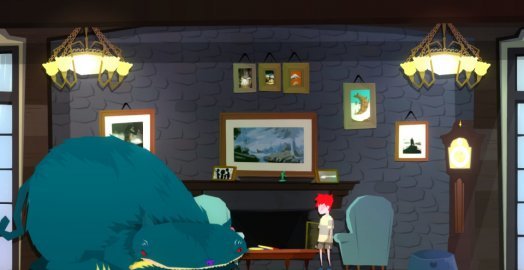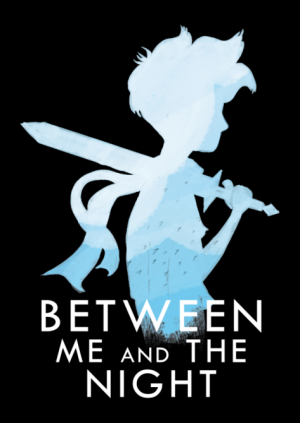Review for Between Me and the Night

We’ve probably all had dreams of being somebody else. Whether it’s an athlete, film star or astronaut, imagining oneself in a different life is a natural form of escapism. For the young protagonist in Between Me and the Night, that fantasy figure is a video game knight. A hero in the virtual world, the boy feels like anything but in the real one; arguing parents and school bullies are just some of the foes that can’t be combatted with a sword and suit of armour. Struggling through this dichotomy makes for an intriguing premise for a game, but while the end result is undeniably great aesthetically, it falls flat in engaging gameplay and seems more satisfied with imagery than real story development.
Between Me and the Night blends traditional adventuring with some basic platforming, but doesn’t excel in either format. My overriding emotion throughout most of the game was that of frustration: next actions are poorly indicated, the controls are clunky, and the whole experience lacks a true narrative as its emotional centre. However, perhaps the most frustrating part of all is seeing how close it is to being a much better game.
You control a red-haired youth, nameless and fairly faceless, through three key stages in his early life. The tale begins in the loft of his family home: two giggling silhouetted figures are playing a video game in front of the TV, but as you sit to join them they vanish like whispers into the darkness. This is compounded by other mystery figures appearing, like the one that rattles in the closet and vanishes on sight. It’s certainly a compelling opening; the quiet, comfortable familiarity of the boy’s room contrasts eerily against the supernatural elements.
Ten minutes in is when my first problem began, which would go on to plague much of the game. The issue is that it’s rarely communicated what you need to do next. I’m all for puzzle complexity when it’s logical, but it’s a hassle having to spend a chunk of time just aimlessly clicking around to work out what will allow you to progress. There’s a particular point where you have to recover an object but are unable to pick it up. It turns out you not only need help from someone, which isn’t indicated, but to get their assistance you have to perform a seemingly unrelated and unimportant task. It’s a tough sequence only because of the lack of adequate signposting, rather than the difficulty of the obstacle itself.
You can inspect a lot of items in the environment and even pick a number of them up, though you’ll collect far more things than you’ll ever actually need. When I played the launch version, the inventory had a limit on storing multiple objects of the same size, which was inconsistent and unnecessary, but this restriction has wisely been removed in a patch update. Though none of the puzzles require inventory combination, you will need to collect objects to aid your progress. One instance requires starting a fire in a science laboratory, where you must first figure out what chemicals you need before hunting them down and conjuring the flames.
As you begin to explore the large and lonely house, you’ll encounter visions of bickering parents and a grumpy sibling, and discover telephone answering machine messages of someone reaching out. Later scenes pit the protagonist against school bullies and then young adult responsibilities like paying bills. There’s barely any dialogue, none of it spoken, nor is there any real character interaction. Instead, you’re left to piece together the backstory for yourself, which would be fine except that apart from the broad strokes there’s not really anything to get your teeth into. There are tidbits like the medicine present in many bathroom cabinets that provide some allure, but it’s all very superficial. This is a character who feels withdrawn and scared – that much is clear from the atmosphere – but not much is done to delve into this theme and turn it into a gripping tale.
For example, in the school you witness a girl lose her camera, so it’s up to you to get it back and then work your way into the photography class to return it. That’s all well and good, but there’s no reason offered for doing this or what it means in the wider context. Earlier, a clock breaks, so now you have to fix it – but why? These feel like tasks for the sake of it rather than essential, character-building incidents. Perhaps there’s something being said about the mundanities of life – feeding the cat, mowing the lawn, making a sandwich – but that’s a stretch and doesn’t translate well into an exciting gameplay experience, no matter the intention or message behind it.
Each of the three time periods has its own monsters inhabiting it. In the first two, they only come out at night and slowly skulk around. When they see you they’ll speed up, your capture causing you to respawn in a base room (though you won’t lose progress). There are ways of combatting these foes, whether using light or an inventory possession, but it’s unnerving to suddenly come across one. For example, the creature in the school takes a tall and gangly form, a pair of keys clinking at its side which you can hear from down the hall. Unfortunately, while adding an air of creepiness, they can negatively get in the way. Sometimes a monster would refuse to leave a particular corner I needed to get to, meaning it ended up being quicker to let myself get caught and have its position reset. Nevertheless, when it works the presence of lurking enemies makes for a nice change of pace from normal adventure fare.
Between these adventure sections comes the platforming, which probably takes up around a fifth of actual play time. The boy is literally sucked into the virtual world when dictated by the story, through televisions and arcades, armouring up and becoming a sword-wielding knight against an ethereal backdrop. The actual platforming isn’t particularly complex here. You can slash and defend as you fight enemy knights and archers, but you don’t really need to use your shield. It’s essentially a button basher, in the sense that you’re repeatedly hitting the attack key until whatever is blocking your way falls down. When you’re not doing that, you’re flipping the occasional switch and running along ledges and up staircases. Again, these are forgiving in difficulty, apart from a sequence right near the end which is punishing purely due to the clunky controls and bad design.
These dream-like scenes aren’t really that much fun to play, either, but I found them appealing for other reasons. Scattered amongst the wintery and mountainous landscape are objects from the real world, some mundane and some meaningful, like an armchair or family photo. Such items represent everyday life bleeding into the virtual one. And for all the game’s larger storytelling faults, I appreciated what it was trying to do here. Here’s a character that is unhappy and scared in his real life, and thus uses the medium of video games to feel stronger and braver.
There are several little optional side quests that you can partake in as well, which will reward you with both internal satisfaction and a Steam achievement, whichever is more important to you. These include gathering together all the toys scattered around the house and collecting all the stickers to complete a poster. There are also a number of retro-style games that you can jump into, complete with pixel art and beep-boop sounds. While these don’t play particularly smoothly from a mechanical perspective, they’re fun little distractions while they last.
Without a doubt, the standout element of Between Me and the Night is its graphic design. With its colourful and clean 2D style, everything looks a bit wonky with atmospheric oddities. A rug droops outside of a room’s visible borders, windows are angled at a slant, and posters are peeling off the wall. Smooth and circular edges aren’t the order of the day here. There’s a day/night cycle which provides some stark contrast in lighting and makes you appreciate the warm glow that lamps give off, especially when the rain is pouring outside. While not every scene is packed with detail, in others there are nice little visual flourishes like a replica Matisse painting on the wall or outdoor terrain that just crumbles off into nothing. The confined viewing areas of real-world scenes are surrounded by black borders, with rooms fading in and out as you travel between them. This contrasts the full-screen outdoor fantasy sections, which are free of such limitations – perhaps a clever way of emphasising the claustrophobic oppression of the boy’s daily burdens. The game's only visual negative is in the school design, where rooms often feel repetitive.
There are two particular artistic details that stick in my mind the most. The first is the family cat, which the boy is scared of feeding and imagines being a huge, red-eyed beast. It’s actually an alarming sight at first, simply due to the sheer size of it. It reminded me of a creature straight out of a Studio Ghibli film, which I mean as sincere praise. The second comes later on, when the boy has become a young man. He’s sitting on the sofa, the glow of the television on his face, and vast amounts of envelopes tumble down from the sky and pile up around him. Not only does it look really cool, but it’s superbly effective in representing the character’s emotions.
The soundscape is excellent too. The music is evocative and haunting, moody and downbeat, with slow piano and strings playing in the background. It’s often quite subdued, but it’s all the more powerful for it. The score brings a foreboding sense to everything, yet there are elements of innocence that shine through simultaneously. In the virtual world the music shimmers and echoes, which adds to the fantastical feel. This atmosphere is capably supported by sound effects, too. Whether the wind rushing by, the sirens outside or the patter of a monster, everything works together to create a sad, creepy vibe.
There’s full controller support, but I found playing with a keyboard and mouse the better of the two methods, though even that is far from ideal. You directly control movement with the keyboard and then left-click hotspots to begin interacting, which seems like a redundant step. You then click again to inspect an object for a brief description, with a third click resulting in picking the item up, assuming it’s allowed and is in reach. The fact that everything has to be within a certain radius before you can do anything with it proves annoying. It’s done because sometimes you’ll have to climb on a box or chair to reach higher up, but the rest of the time it’s just a bit pointless.
Making matters worse, the game won’t necessarily acknowledge what you want to do. For example, when climbing up a group of objects you need to have them all precisely placed. It’s similar when trying to move something, which you do by holding right-click, in that it won’t process the action unless you’re in a very specific position. My aggravation accumulated right to the end of the game, when I was certain I’d solved a puzzle but nothing was happening. I spent ages roaming around trying to figure out what I was missing – turns out I just had to slightly reposition my solved puzzle object for it to register.
I also encountered one game-breaking bug which rendered all doors black and prevented me from moving between rooms. This may have been fixed in the subsequent patch, as some other bugs were, but it occurred seemingly at random during my playthrough, so I have no way to know for sure. There’s no manual save system, with checkpoints available only between chapters, which can be hours apart, meaning I had to quit out and lose a bunch of progress. Frankly, the bug is more forgivable than the archaic save system. For a game that spent quite a while in Steam Early Access, it’s disappointing to see such obvious and correctible issues still exist in the finished release.
At around four hours in length, I really wanted to like Between Me and the Night more than I did. There are clearly some good ideas bubbling under the surface, but they haven’t been fully fleshed out. The themes of loneliness and imaginary retreat into fantasy are ripe for exploration, but while the visuals are nailed in presenting these ideas, the story does little more than scratch the surface. A more cohesive plot would have given it much more emotional resonance, while the puzzles should support the main character’s development rather than feeling like an afterthought. Props have to be given to first-time developer RainDance for successfully creating an immersive environment to explore, and hopefully their future output will benefit from lessons learnt here, but the art, audio, and premise alone aren’t enough to make this platforming adventure hybrid worthy of a strong recommendation.






























